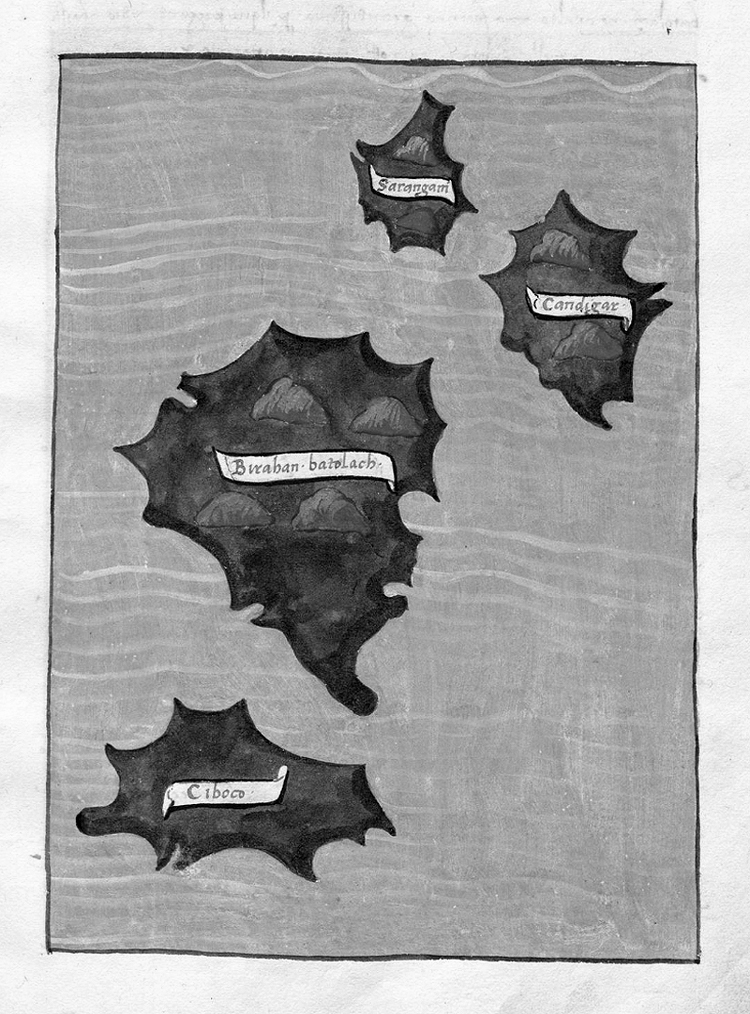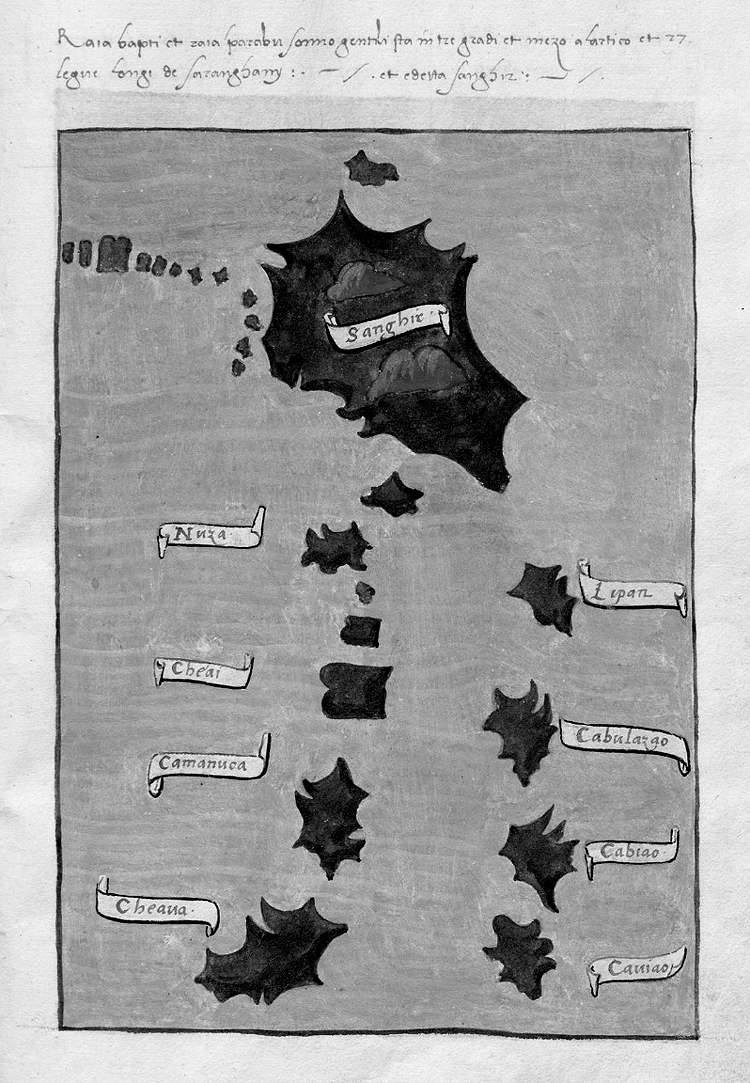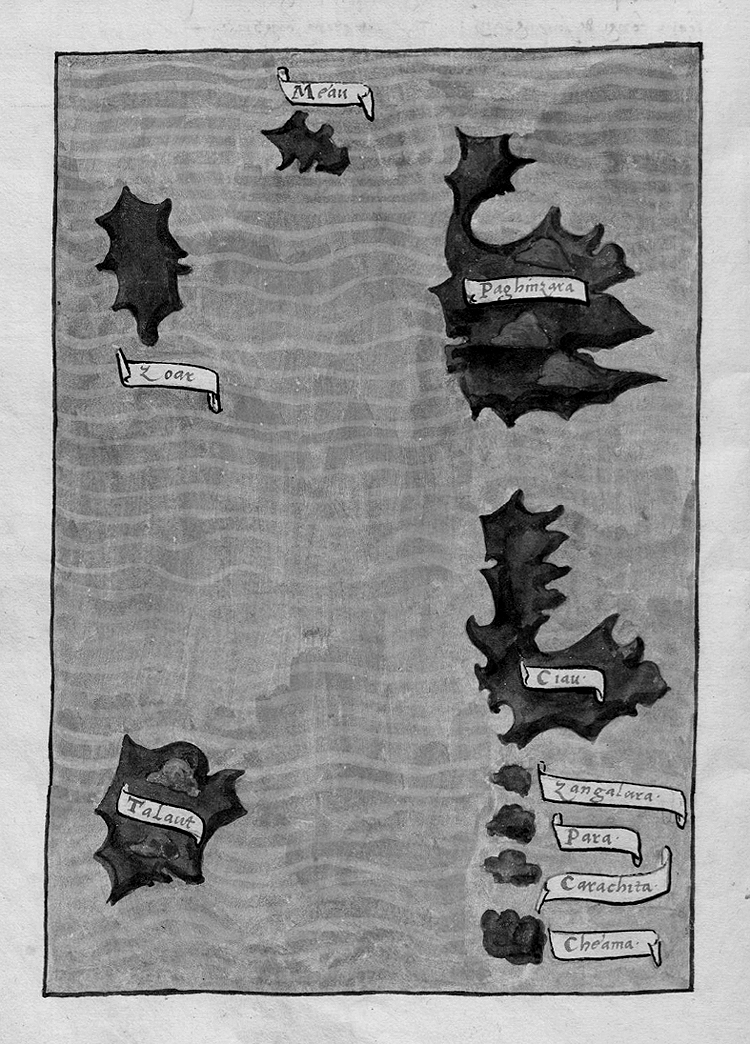|
Ottobre 1521
Poy al leuante carta del grego pasassemo fra dui habitatiōe dete cauit et subanin et vna Jsola habitata deta monoripa longi x legue da li monticeli La gente de questa hanno loro case in barche et non habitano altroue in qelle due habitatiōe de cauit et subanin liqalli sonno ne la ysola de butuan et Calaghan nasce la meglior Canella ɋ si possa trouare se stauāo iui þ dui giornj ne carigauano le naui ma þ hauer bon vento apasare vna ponta et certe ysollete ɋ erano circha de questa nō volessemo tardaȓ et andando a la vella baratassemo disisette libre þ dui cortelli grandi haue vamo tolti aL gouuernatoȓ de pulaoan larbore de questa Cannella he alto tre o catro cubito et grosso como li diti de La mano et nō ha piu de tre o catro rameti la sua foglia he como qella deL lauro La sua scorsa he La Cannella La se coglie due volte a lanno cosi e forte lo legnio et le foglie essendo verde como la cannella la chiamāo caiu mana Caiu vol dire legno et mana dolce çioe legnio dolce.
Pigliando Lo camino aL grego et andando a vna cita grande detta maingda nao Laqalle he nela ysola de butuan et calaghan acio sapessemo qaLque noua de maluco pigliassemo þ forsa vno bigniday e come vno prao et amazassemo sette homini in questo erano solum dizidoto homini disposti Quanto alguni alti vedessemo in queste parte tucti deli principali de ma ingdanao fra questi vno ne disse ɋ era fratello del re de maingdanao et che sapeua doue era malucho þ questo lasassemo la via del grego et pigliasẽo la via de siroco in vno capo de questa ysola butuan et caleghan apresso de vno fiume se trouano hominj pelozi grandissimi combatitori et arciere anno spade largue vno palmo mangiāo sinon Lo core deL huomo crudo cō sugo de neranzi o limoni et se chiamano benaian li pelosi Quando pigliassemo La via deL siroco stauamo in sey gradi et sete menuti aLartico et trenta legui longi de cauit.
Andando aL siroco trouassemo Quatro ysolle Ciboco biraham batolach Saranganj et candighar vno sabato de nocte a vinti sey de octobre costeando birahan batolach ne assalto vna fortuna grandissima þ ilque pregando ydio abassa semo tucte le velle Subito li tri nosti sancti ne aparsero descaciando tuta lascuritate sto. elmo stette piu de due hore incima lagabia como vna torchia sto. nicolo in cima dela mezana et sta chiara soura lo trinqueto þmetesemo vno schiauo asancto elmo a sto nicolo et a Sta. chiara gli dessemo a ogny vno lasua elemosina seguendo poy nȓo viagio intrassemo in vno porto in mezo de le due ysolle Saranghani et candighar et se afermassemo aL leuante apresso vna habitatiōe de sarangani oue se troua oro et perle Questi populi sonno gentili et vano nudi como gli alti Questo porto sta de latitudine in cinque gradi et noue menuti et longi cinquanta legue de cauit.
Stando quiui vno giorno pigliassemo dui piloti þ forsa acio ne insegniaseno malucho facendo nȓo viagio fa mezo giorno et garbin pasassemo þ octo ysole habitate et deshabitate poste in modo de vna via leqalle se chiamano Cheaua Cauiao Cabiao Camanuca Cabaluzao cheai lipan et nuza fin que ariuassemo in vna ysola posta in fine de queste molto bella aL vedere þ hauere vento contrario et þ non potere passare vna ponta de questa yso la andauamo dequa et dela çirca de ella þ ilque vno de qelli haueuamo pigliati a saranghai et Lo fratello deL re de maingdanao cō vno suo figliolo picolo ne la nocte fugirono nuotando in questa ysola ma iL figliolo þ nō potere tenere saldo soura le spalle de suo padre se anego þ nō potere caualcare la dicta punta passasemo de soto dela ysola doue erano molte ysolette Questa ysola tenne quato re raia matandatu raia lalagha Raia bapti et raia parabu sonno gentili sta in tre gradi et mezo a lartico et 27. legue longi de saranghany. et edetta sanghir.
Facendo lo medesimo Camino pasassemo zirca sey Jsolle cheama Carachita para zanghalura Ciau lontana diece legue da sanghir Questa tenne vno mōte alto ma nō largo lo suo re chiama raia ponto et paghinzara Longo octo legue da ciau laqalle a tre montagnie alte Lo suo re se chiama raia babintan talaut poy trouassemo aL leuante de paghinzara longi dodici legue due ysolle nō molto grandi habitate dette zoar et meau passate queste due ysolle mercore asey de nouembȓ discopersemo quato ysolle alte aL leuante Longi dale due cadordice legue Lo pilloto ɋ ne era restato disse Como qelle quatro ysolle erāo maluco þ ilque rengratiassemo ydio et þ allegreza descaricassemo tuta La artigliaria non era de marauiliarsi se eramo tanto alegri perche haueuāo passati vintisette mesi mancho dui giorni in cercare malucho þ tute qƺste ysolle [þ tute queste ysolle: doublet in original MS.] fin amalucho eL menor fondo trouassemo era in cento et ducento bracia aL contrario Como diceuāo li portuguesi ɋ quiui nō si poteua nauigare þ li grā bassi et iL çiello obscuro como loro Se haueuāo ymaginato.
|
|
Then we laid our course east by north between two settlements called Cauit and Subanin, and an inhabited island called Monoripa, located x leguas from the reefs. The people of that island make their dwellings in boats and do not live otherwise. In those two settlements of Cavit and Subanin, which are located in the island of Butuan and Calaghan, is found the best cinnamon that grows. Had we stayed there two days, those people would have laden our ships for us, but as we had a wind favorable for passing a point and certain islets which were near that island, we did not wish to delay. While under sail we bartered two large knives which we had taken from the governor of Pulaoan for seventeen libras [of cinnamon]. The cinnamon tree grows to a height of three or four cubits, and as thick as the fingers of the hand. It has but three or four small branches and its leaves resemble those of the laurel. Its bark is the cinnamon, and it is gathered twice per year. The wood and leaves are as strong as the cinnamon when they are green. Those people call it caiu mana. Caiu means wood, and mana, sweet, hence, «sweet wood.»
Laying our course toward the northeast, and going to a large city called Maingdanao, which is located in the island of Butuan and Calaghan, so that we might gather information concerning Maluco, we captured by force a bigniday, a vessel resembling a prau, and killed seven men. It contained only eighteen men, and they were as well built as any whom we had seen in those regions. All were chiefs of Maingdanao, among them being one who told us that he was a brother of the king of Maingdanao, and that he knew the location of Malucho. Through his directions we discontinued our course toward the northeast, and took that toward the southeast. At a cape of that island of Butuan and Caleghan, and near a river, are found shaggy men who are exceedingly great fighters and archers. They use swords one palmo in length, and eat only raw human hearts with the juice of oranges or lemons. Those shaggy people are called Benaian. When we took our course toward the southeast, we lay in a latitude of six degrees and seven minutes toward the Arctic Pole, and thirty leguas from Cavit.
Sailing toward the southeast, we found four islands, [namely], Ciboco, Biraham Batolach, Sarangani, and Candighar. One Saturday night, October twenty-six, while coasting by Birahan Batolach, we encountered a most furious storm. Thereupon, praying God, we lowered all the sails. Immediately our three saints appeared to us and dissipated all the darkness. St. Elmo remained for more than two hours on the maintop, like a torch; St. Nicholas on the mizzentop; and St. Clara on the foretop. We promised a slave to St. Elmo, St. Nicholas, and St. Clara, and gave alms to each one. Then continuing our voyage, we entered a harbor between the two islands of Saranghani and Candighar, and anchored to the eastward near a settlement of Sarangani, where gold and pearls are found. Those people are heathens and go naked as do the others. That harbor lies in a latitude of five degrees nine minutes, and is fifty leguas from Cavit.
Remaining one day in that harbor, we captured two pilots by force, in order that they might show us where Malucho lay. Then laying our course south southwest, we passed among eight inhabited and desert islands, which were situated in the manner of a street. Their names are Cheaua, Cauiao, Cabiao, Camanuca, Cabaluzao, Cheai, Lipan, and Nuza. Finally we came to an island at their end, which was very beautiful to look at. As we had a contrary wind, so that we could not double a point of that island, we sailed hither and thither near it. Consequently, one of the men whom we had captured at Saranghai, and the brother of the king of Maingdanao who took with him his small son, escaped during the night by swimming to that island. But the boy was drowned, for he was unable to hold tightly to his father's shoulder. Being unable to double the said point, we passed below the island where there were many islets. That island has four kings, [namely], Raia Matandatu, Raia Lalagha, Raía Bapti, and Raia Parabu. The people are heathens. The island lies in a latitude of three and one-half degrees toward the Arctic Pole and is 27 leguas from Saranghany. Its name is Sanghir.
Continuing the same course, we passed near six islands, [namely], Cheama, Carachita, Para, Zanghalura, Ciau (which is ten leguas from Sanghir, and has a high but not large mountain, and whose king is called Raia Ponto), and Paghinzara. The latter is located eight leguas from Ciau, and has three high mountains. The name of its king is Raia Babintan. [Then we found the island] Talaut; and we found twelve leguas to the east of Paghinzara two islands, not very large, but inhabited, called Zoar and Meau. After passing those two islands, on Wednesday, the sixth of November, we discovered four lofty islands fourteen leguas east of the two [abovementioned islands]. The pilot who still remained with us told us that those four islands were Maluco. Therefore, we thanked God and as an expression of our joy discharged all our artillery. It was no wonder that we were so glad, for we had passed twenty-seven months less two days in our search for Malucho. Among all those islands [among all those islands: doublet in original MS.], even to Malucho, the shallowest bottom that we found was at a depth of one or two hundred brazas, notwithstanding the assertion of the Portuguese that that region could not be navigated because of the numerous shoals and the dark sky as they have imagined.
|

Biblioteca ambrosiana di Milano, Ms. L 103 Sup., fol. 50r

Biblioteca ambrosiana di Milano, Ms. L 103 Sup., fol. 51r

Biblioteca ambrosiana di Milano, Ms. L 103 Sup., fol. 51v
|